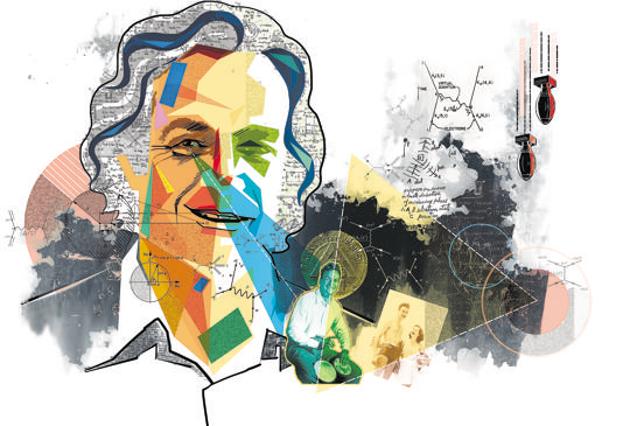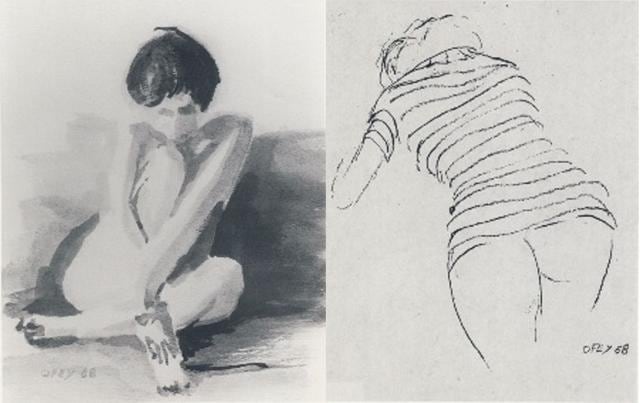Feyn Balance: Meet one of the world’s most influential, colourful physicists
Richard Feynman was the pacifist who developed the atomic bomb, the safecracker, the Nobel laureate who solved physics problems in topless bars, and he would have been 100 this month.
With physics, the closer you get, the harder it becomes to see. Zoom past atoms and electrons into the nucleus, and you’ll find quarks. Actually you won’t. No one’s seen them; only data proves they exist.

It takes a genius to understand what’s going on. But it takes a genius of truly epic proportions to understand why, and then turn that knowledge into something useful, while also finding ways to explain it to non-geniuses without the use of complicated equations.
Richard Feynman, the American Nobel Prize-winning physicist who would have been 100 this month, is precisely that kind of genius. He helped solve some of the toughest problems of the post-war years with work in low-temperature physics, quantum computing, nanotechnology and electrodynamics. He’s also one of the last of a generation of rockstar scientists (Einstein, Oppenheimer, Hawking) - eccentric experts who lived by their own rules and changed the way we think of science itself. Take a look at Feynman’s incredible life.
On the one hand...
Feynman earned his Nobel Prize in 1965 for helping develop a theory of quantum electrodynamics (QED) which describes how light and matter interact. But in his 70 years (he died of cancer in 1988) he contributed to varied fields. Scientists and biographers tend to mention his knack for being able to pick the right problem at the right time. Feynman described it has “just being curious”.
With QED alone, Feynman made life easier for physicists, inventing a new branch of maths that incorporated figures and illustrations instead of complicated equations for calculations. Those diagrams – squiggles, arrows and shapes – are today the standard notations for work on everything from the behaviour of subatomic particles to the way galaxies evolve.
“He basically taught us how light works,” says Amol Dighe, dean of graduate studies at the TIFR Deemed University who researches ways to understand fundamental interactions of elementary particles. “But he roamed free across so many branches of physics – path integral formulation, nanotechnology and thermodynamics – and successfully made connections between them. That kind of genius comes only once every few decades.”
It’s no surprise that at 24, Feynman was among the top minds recruited to the top-secret Manhattan Project to build an atomic bomb for use against the Germans in the early 1940s. He helped engineers calculate safety procedures to avoid accidents with stored radioactive material and watched the first nuclear weapon detonate as part of the US Army’s Trinity test in 1945.

By the ’50s Feynman was deeply interested in why liquid helium, at temperatures near zero, behaved so oddly - it would leak through molecule-thin cracks, flow up and over the sides of a dish, and remain still even when its container was spun. What resulted was a quantum-mechanical explanation for the theory of superfluidity, when a liquid flows without friction.
He worked on a theory about the force that governs radioactive decay; took a break from physics to work on viruses; and offered potential applications for nanotechnology by watching how ants behaved. By 1968, he’d worked out what goes on inside an atom’s nucleus. He called the hypothetical particles partons, which helped physicists later understand quarks.
In 1986, two years before his death, Feynman began work on what would be his final project. He was the only scientist on an official team investigating why NASA’s Challenger space shuttle exploded seconds after take-off, killing all seven astronauts on board. Losing patience with bureaucracy, he flew across the US, doing his own digging, and presented his answer on TV. Feynman dropped a ring-shaped rubber gasket into a glass of ice water to demonstrate that the material would not show resilience, much like the shuttle’s O rings on the fateful, freezing day. It proved that NASA managers had ignored their engineer’s warnings to abort the launch due to the cold. His conclusion: “For a successful technology, reality must take precedence over public relations, for nature cannot be fooled.”
On the other hand...
American physicist and author Leonard Mlodinow, Feynman’s colleague in his final years, looks at his friendship with the physicist in his 2003 book, Feynman’s Rainbow. “He himself behaved much like an electron,” Mlodinow says.
At the California Institute of Technology, he was a regular at local strip clubs, seeing them as ideal places to clear his head as he worked out physics theories on napkins.
That he played the bongos is legendary. But Feynman also played them well enough to accompany performers at a ballet. A few years after he’d developed his diagrams, he bartered physics coaching for art lessons with the artist Jirayr Zorthian. His work covered everything from portraits to sketches of strippers and female nudes.
During the Manhattan Project, he passed the time at the remote New Mexico facility by learning to crack open safes and breaking into file cabinets containing sensitive material about bomb building. People were simply unprepared. They installed better locks but he just got smarter, leaving notes insides the safes, signed ‘Feynman the Safecracker’. He was eventually banned from entering several offices. After the war, he pursued his love for puzzles by becoming an expert on Mayan hieroglyphics.

In 1959 Feynman challenged fellow scientists to print an encyclopaedia on a space the size of a pinhead. They did it in 1986.
He’s used probability theories to chat up women, he experimented with drugs, he was probably the only Nobel laureate to have gatecrashed a wedding reception. And on campus, he drove a van decorated in his famous diagrams, bearing vanity license plates that spelt QUANTUM.
Just to keep things interesting, he also had a bit role in Anti-Clock, the 1979 film about dreams visualised on computers, He played a professor.
Early start
Feynman was destined for the lab. “If he’s a boy I want him to be a scientist,” his father, Melville, a salesman, is rumoured to have said to his pregnant wife Lucille. Young Feynman grew up reading the Encyclopaedia Britannica on his father’s lap and recalls how his dad would help him understand that a dinosaur was not 20 feet tall, but tall enough to peek at them from a first-floor window. “He was not about the facts but about the process,” Feynman recalls in one video.
By age 10, he had his own laboratory, perfect for pranks. Feynman once put sodium ferrocyanide in the bathroom towels and an iron salt in the soap to give his mother blue hands from the ink they’d create when combined. She was horrified and screamed - but only about her good linen.
He also taught himself trigonometry, advanced algebra, analytic geometry and calculus, winning school maths championships and ultimately getting an unprecedented perfect score in the maths and physics entrance exams at Princeton.
Life changed when his childhood sweetheart and wife Arline died of TB four years into their marriage, the same year the bomb Feynman helped develop was dropped on Japan, killing 80,000 people. Science affected his attitude to death, he says in Feynman’s Rainbow. “I didn’t get mad when Arline died. Who was there to be mad at? I couldn’t get mad at God because I don’t believe in God. And you can’t get mad at bacteria, can you?”
Still, he lost focus, womanising and frequenting Vegas for the show girls. The one day, in the university canteen, a plate thrown by a student at lunchtime clattered to the floor. Feynman observed that it rotated faster than it wobbled, making him wonder if the two motions were related. It broke the spell and got him thinking again.

Theory of legacy
The story goes that when a reporter phoned him in the middle of the night to break the news that he’d won the Nobel Prize, Feynman told him to call back at a decent hour, and hung up. The pleasure, he said, was in finding things out and seeing other people use it.
If scientists see Feynman as an uncommon mind, the rest of us see him as the scientist with the uncommon voice. In his pursuit of truth and new breakthroughs, he tirelessly pushed for reforms in science education so it was about exploring ideas rather than learning names and definitions.
“His insightfulness, I think came from being able to understand the ideas so well himself,” says Dighe. “Even today I recommend his three volumes on physics to all my students. While other textbooks gave formulas, he could explain why and how a particle was connected to thermodynamics. If we had more Feynmans perhaps we’d have more students in the pure sciences.”
Those three-volume lectures on physics are legendary (see box). Microsoft founder Bill Gates has said that if he’d watched them earlier in his life, he might have become a physicist instead of a software entrepreneur. In 2009, Gates bought the rights to The Character of Physical Law, a series of videos of seven lectures Feynman gave at Cornell University, to share them for free online. In 2016, he also wrote an article, ‘The best teacher I never had’, in praise of the physicist’s lectures.
Govind Mukundan, 37, who works in knowledge creation and dissemination in the philanthropy sector, says Feynman was a childhood hero, “but in retrospect, he severely misled me with his infectious love of physics”. Mukundan recalls how, as a boy, his father let him stay up late for nearly two weeks to catch a serialised Feynman documentary on TV. “I was blown away,” he says. He picked physics in Class 11 and 12, hoping for the excitement and experiments, “but it was such a letdown. No one seemed to have any deep appreciation for the subject. Physics was just a gateway subject to score well enough to get into a good college”.
For Dighe, the physicist has helped in remarkable and unexpected ways. “His investigation into the Challenger disaster made everyone realise that there were real-life applications to the complicated calculations that represent physics,” he says. “He also spoke about how learning the names of things, bird species for example, is not the same as understanding them. I’ve always used it as an excuse for not remembering names.”
Catch your daily dose of Fashion, Health, Festivals, Travel, Relationship, Recipe and all the other Latest Lifestyle News on Hindustan Times Website and APPs.




